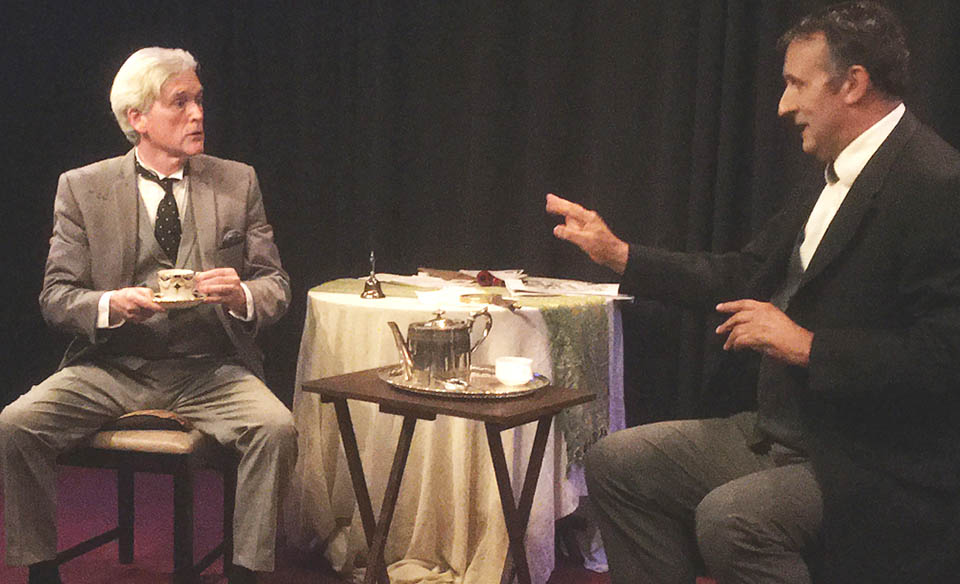
As every Sherlock Holmes enthusiast knows, Holmes and Dr. Watson shared rooms at No 221b Baker Street, which in Sir Arthur Conan Doyle’s time was one of London’s residential districts. Recently, the sitting room of the apartment and its two famous occupants were recreated at Ben’s Theater in Jomtien for the stage production, The Return of Sherlock Holmes.
In Doyle’s time, the house numbers in Baker Street only went up to No 85. When it was merged with another street in the 1930s, the odd numbers from 215 to 229 were assigned to a building which was the home of the Abbey Road Building Society. Almost immediately, the company started receiving countless letters addressed to Mr. Sherlock Holmes. They eventually appointed a full-time secretary to deal with them.
The Return of Sherlock Holmes was Arthur Conan Doyle’s fourth collection of short stories and published in 1905. Doyle began writing about the detective and his side-kick in the 1880s; a total of fifty-six short stories and four full-length novels. The first one, A Study in Scarlet was published in The Strand Magazine in 1887. Doyle was twenty-seven at the time and a qualified medical doctor. Subsequent stories appeared in serial form, a common practice at the time. They were later republished as complete books. Although Doyle was one of the best paid authors of his day, he eventually became bored with Holmes and wanted to concentrate on other things, especially historical fiction. Despite his mother’s dismay, Doyle decided to kill off Holmes in a story entitled The Final Problem, published in The Strand Magazine in 1893.
There was a public outcry. Many readers angrily cancelled their subscriptions to The Strand Magazine and it was said that some young men in London donned black arm-bands. The ensuing furore forced Doyle to bring Sherlock Holmes back to life, though not after several years absence. Holmes reappeared in 1903 in a short story called The Adventure of the Empty House, republished two years later in The Return of Sherlock Holmes.
The stage production The Return of Sherlock Holmes is a brilliant two-man show, presented recently at Ben’s Theater, Jomtien. With a script by Owen Thomas, it’s based loosely on The Adventure of the Empty House. Set in 1894, three years after the apparent death of Sherlock Holmes the story concerns an apparently unsolvable London murder: the killing of the Honourable Ronald Adair, part-time gambler and son of the Earl of Maynooth.
In the stage production, Dr. Watson laments the untimely death of his friend Holmes but later we see Holmes disguised as an eccentric bearded book-seller who literally bumps into Dr Watson on the street. Later, at their rooms in Baker Street, Holmes reveals his true identity. He explains to Dr. Watson that reports of his death at Switzerland’s Reichenbach Falls with his arch-enemy Professor Moriarty were false. Only Moriarty had fallen to his death while Holmes had managed to escape. Dr Watson understandably receives this revelation with mixed emotions.
Nigel Miles-Thomas played a compelling Holmes and reminded me of Sir Basil Rathbone, the eminent English actor with the impeccable accent who played Sherlock Holmes in fourteen Hollywood films made between 1939 and 1946. Nigel has been in over a hundred productions worldwide and appeared in popular British television shows including Dr Who, Grange Hill, The Professionals, and The Dick Emery Show. As Holmes, Nigel dominated the stage and played with a real sense of commitment. Daniel Foley gave a thoughtful and affectionate performance of the long-suffering Dr Watson, who in the stories was a successful medical doctor, though not quite in the intellectual league of Holmes. Daniel, who also has a string of theatre and television appearances behind him, played the character with considerable sympathy and understanding. The ensemble work provided some compelling and amusing theatre which delighted the audience.
As I watched with fascination, I began to wonder why Arthur Conan Doyle decided to give his hero the unusual name of Sherlock. The name Holmes was a typical English surname and especially associated with London and the literary world. But Sherlock? According to the American writer Michael Sims, Doyle toyed with several different names for his detective. Originally Doyle was going to call him Sherrington Hope. That mutated into Sherrinford Hope and then into Sherrinford Holmes before finally becoming Sherlock Holmes. It’s possible claims Sims, that the name Sherlock might have been inspired by the real-life Chief Inspector William Sherlock of London’s Metropolitan Police, who was frequently mentioned in newspaper crime reports. Doyle made no secret of the fact that the personal character of the detective was partly modelled on Doyle’s former university teacher Dr Joseph Bell.
Dr Watson was originally going to be named Ormond Sacker. Perhaps it sounded a bit fanciful because later Doyle chose the more mundane Watson instead, possibly inspired by Dr. Patrick Watson in Edinburgh. Or possibly not. We may never know. Dr Watson is the “writer” of nearly all the Holmes stories and we see them unfold through his eyes. This is established in the first title A Study in Scarlet, which is subtitled “being a reprint from the reminiscences of John H. Watson, MD, late of the Army Medical Department.” Towards the end of the story, Watson says to Holmes, “Your merits should be publicly recognized. You should publish an account of the case. If you won’t, I will for you.” And of course, he does.
Nigel Miles-Thomas and Daniel Foley have already presented this fascinating show in many countries. They’ve had plenty of time to get comfortable with the roles and it was a pleasure watching such professional and confident work on the stage at Ben’s Theater. Their years of stage and television work was evident in their compelling stage presence and sensitive portrayal of the two characters that Sir Arthur Conan Doyle crafted so carefully. It was a splendid evening, especially for fans of The Great Detective.
Footnote:
As I was completing this article, I chanced upon a brief uncredited story that illustrates Dr. Watson’s worldly knowledge…
Sherlock Holmes and Dr. Watson are on a camping trip. After an al fresco dinner and a bottle of Bordeaux, they decide to retire for the night. Some hours later, Watson is awoken by a nudge in the arm from Holmes. “Watson, look up and tell me what you see.”
“I see millions and millions of bright shining stars, Holmes,” replies Watson in awe.
“And what do you deduce from that?” Holmes asks. Watson ponders for a moment and replies, “Astronomically, I deduce that there are millions of galaxies and potentially countless planets. In terms of meteorology, the clear sky indicates that there will be a cloudless morning ahead of us. Astrologically, I observe that Saturn is in Leo and furthermore…”
“Yes, yes, Watson,” interrupts Holmes impatiently, “But you have failed to notice a significant point.”
“And what is that?” asks Watson, mystified.
“Watson,” says Holmes slowly, “Someone has stolen our tent.”
 |
 |
 |





